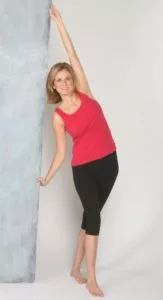In Part 1 and Part 2 of this series on how the position of the pelvis is one of the most common and overlooked causes of shoulder and neck pain you learned about malalignments of the pelvis and how to assess the pelvis to evaluate if it is out of alignment. In this final installment (Part 3) you will learn corrective exercise strategies (that when performed on a regular basis) will help align your pelvis, hips and lumbar spine and alleviate your shoulder and neck pain on both a short and long-term basis.
Addressing the Causes of Shoulder and Neck Pain with Corrective Exercise
Exercise #1: Foam Roller on Side of Hip and Leg
 A sideways shift of the hips and lumbar spine is often caused by restrictions in the opposite hip and muscles that run down the leg (i.e., the hip that appears lower on the dowel rod assessment your learned in Part 2 is usually the restricted side). This self-myofascial release technique will help loosen up these structures and prepare them for the stretching exercise that follows.
A sideways shift of the hips and lumbar spine is often caused by restrictions in the opposite hip and muscles that run down the leg (i.e., the hip that appears lower on the dowel rod assessment your learned in Part 2 is usually the restricted side). This self-myofascial release technique will help loosen up these structures and prepare them for the stretching exercise that follows.
Lie on your side and place the roller underneath your body on the lateral side of the leg/hip that appeared lower on the assessment. Move the roller gently up and down your leg and hip pausing on any sore spots you find. Perform at least once per day on that side for a total of 2 – 3 minutes.
Exercise #2: Door Frame Stretch
This stretching exercise is designed to mobilize the hip that appeared lower (from the dowel rod assessment) so the body can begin to accept weight correctly on that side and help balance the hips.
 Stand in a door frame and reach the arm of whichever side of the hip appeared lower in the assessment over your head. Grasp the doorframe above head level with the hand of the upstretched arm. Place your other hand lower on the frame at thigh level and tuck your outside foot behind your inside foot. Push your inside hip away from your hands and shift your weight into your outside hip until you feel a stretch. Hold for 20 – 30 seconds and perform at least once per day.
Stand in a door frame and reach the arm of whichever side of the hip appeared lower in the assessment over your head. Grasp the doorframe above head level with the hand of the upstretched arm. Place your other hand lower on the frame at thigh level and tuck your outside foot behind your inside foot. Push your inside hip away from your hands and shift your weight into your outside hip until you feel a stretch. Hold for 20 – 30 seconds and perform at least once per day.
Exercise #3: Side Lying Leg Lift
 A sideways shift of the hips can also result from a weakness on the side of the hip that appeared higher in the assessment as the abductors become ineffective at stabilizing the pelvis/hip/leg during movement. This exercise strengthens the gluteus medius and minimus on the higher-hip side to help keep the pelvis, hips and lumbar spine centered.
A sideways shift of the hips can also result from a weakness on the side of the hip that appeared higher in the assessment as the abductors become ineffective at stabilizing the pelvis/hip/leg during movement. This exercise strengthens the gluteus medius and minimus on the higher-hip side to help keep the pelvis, hips and lumbar spine centered.
Lie on whichever side of your body that the hip appeared lower in the assessment with your head supported. Bend the knee of the leg on top and position the instep of that foot on the inside of your bottom leg at knee level. Posteriorly rotate your pelvis (i.e., tuck it under) and gently lift the knee of your top leg without arching your lower back or rotating your hips. Perform this exercise slowly, allowing plenty of time for your nervous system to connect to the muscles on the sides of your hips/buttocks. Perform 10 to 12 repetitions once a day.
Understanding and Addressing the Causes of Pain
An appreciation of how the whole body works together as a kinetic chain is essential when understanding what causes painful symptoms like shoulder and neck pain. Utilizing assessments that identify the underlying causes of neck and shoulder pain and addressing those issues with corrective exercises can help you and your clients move better while eliminating long-standing aches and pains.
Fitness, exercise and health professionals interesting in learning how to assess and correct the underlying causes of their client’s aches and pains with corrective exercise can choose to enroll in the industry’s highest-rated Corrective Exercise Specialist certification course from The BioMechanics Method. To learn more about this amazing program click on the image below.
